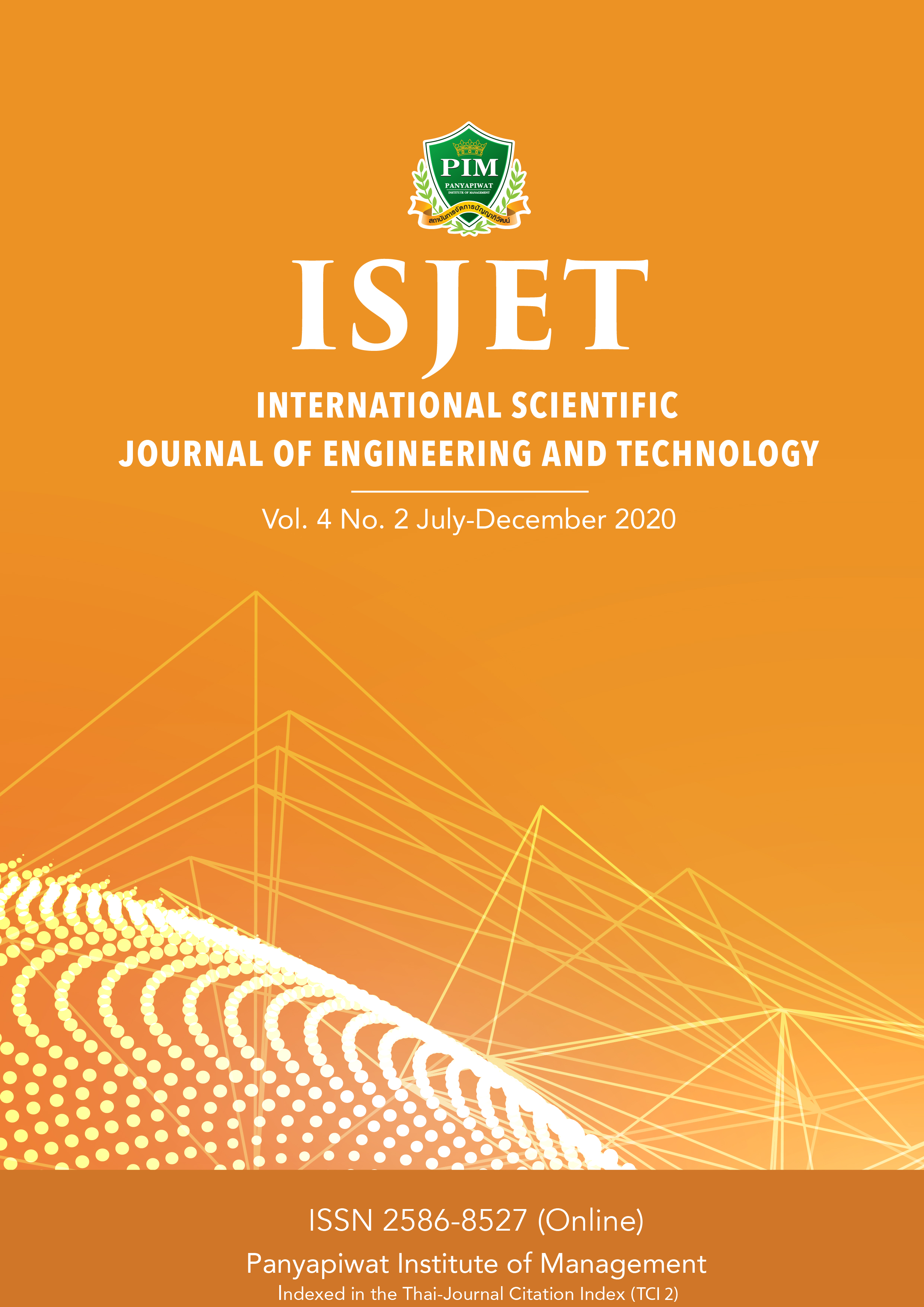Bullwhip effect Prediction in a Single Echelon Supply Chain Using a Regression Analysis
Main Article Content
Abstract
One of the main problems in supply chain systems is the bullwhip effect that can generate a huge cost for the companies in a chain.In this study, the factors and their impacts that can cause the bullwhip effect (order variance and net stock amplification) are investigated by using a simulation-based optimization approach. The proposed meta-prediction model is built using regression analysis, to predict the Total Stage Variance Ratio (TSVR) of the system. A single-echelon supply chain with uncertain customer demand operating under the periodic-review reorder cycle policy is studied. The parameters of the smoothing inventory replenishment and forecasting methods are required to search for their optimality in reducing the TSVR by OptQuest, an optimization tool in ARENA simulation software. Our results can assist decision makers in the management of a supply chain, to realize, benchmark, and reduce the TSVR under an uncertain environment.
Article Details

This work is licensed under a Creative Commons Attribution-NonCommercial-NoDerivatives 4.0 International License.
เนื้อหาข้อมูล
References
A. Shaban and M. A. Shalaby, “Modeling and optimizing of variance amplification in supply chain using response surface methodology,” Computers & Industrial Engineering, vol. 120, no. 1, pp. 392-400, June. 2018.
S. Kongkiatpaiboon1 and P. Chutima. (2017, Jun.). Logistics improvement: A case study of automotive part distribution. International Scientific Journal of Engineering and Technology [Online]. 1(1), pp. 31-35. Available: ph02.tci-thaijo.org/index. php/isjet/article/view/175778/125587
J. Dejonckheere, S. M. Disney, M. R. Lambrecht et al., “The impact of information enrichment on the bullwhip effect in supply chains: A control engineering perspective,” European Journal of Operational Research, vol. 153, no. 3, pp. 727–750, Mar. 2004.
X. Wang and S. M. Disney, “The bullwhip effect: Progress, trends and directions,” European Journal of Operational Research, vol. 250, no. 3, pp. 691-701, May. 2016.
F. Costantino, G. D. Gravio, A. Shaban, and M. Tronci, “The impact of information sharing and inventory control coordination on supply chain performances,” Computers & Industrial Engineering, vol. 76, no. 1, pp. 292-306, Oct. 2014.
S. M. Disney and M. R. Lambrecht, “On replenishment rules, forecasting, and the bullwhip effect in supply chains,” Foundation and Trends in Technology Information and Operations Management, vol. 2, no. 1, pp. 1-80, Apr. 2008.
F. Chen, Z. Drezner, J. K. Ryan et al., “Quantifying the bullwhip effect in a simple supply chain: The impact of forecasting, lead times, and information,” Management Science, vol. 46, no. 3, pp. 436-443, Mar. 2000.
Y. Yu, R. Q. Cao, and D. Schniederjans, “Cloud computing and its impact on service level: A multi-agent simulation model,” International Journal of Production Research, vol. 55, no. 15, pp. 4341-4353, Oct. 2016.
J. Dejonckheere, S. M. Disney, M. R. Lambrecht et al., “Measuring and avoiding the bullwhip effect: A control theoretic approach,” European Journal of Operational Research, vol. 147, no. 3, pp. 567-590, June. 2003.
M. M. Naim, V. L. Spiegler, J. Wikner et al., “Identifying the causes of the bullwhip effect by exploiting control block diagram manipulation with analogical reasoning,” European Journal of Operational Research, vol. 263, no. 1, pp. 240-246, Nov. 2017.
D. C. Chatfield, J. G. Kim, T. P. Harrison et. al., “The bullwhip effect impact of stochastic lead time, information quality, and information sharing: A simulation study,” Production and Operations Management, vol. 13, no. 4, pp. 340-353, Dec. 2004.
F. Costantino,G.D. Gravio, A.Shaban,and M.Tronci,“Smoothing inventory decision rules in seasonal supply chains,” Expert Systems with Applications, vol. 44, pp. 304-319, Feb. 2016.
R. N. Boute, S. M. Disney, M. R. Lambrecht, and B. V. Houdt, “An integrated production and inventory model to dampen upstream demand variability in the supply chain,” European Journal of Operational Research, vol. 178, no. 1, pp. 121-142, Apr. 2007.
R. N. Boute, S. M. Disney, M. R. Lambrecht et al., “Designing replenishment rules in a two-echelon supply chain with a flexible or an inflexible capacity strategy,” International Journal of Production Economic, vol. 119, no. 1, pp. 187-198, May. 2009.
X. Zhang, “The impact of forecasting methods on the bullwhip effect,” International Journal of Production Economics, vol. 88, no. 1, pp. 15-27, Mar. 2004.
D. Wright and X. Yuan, “Mitigating the bullwhip effect by ordering policies and forecasting methods,” International Journal of Production Economics, vol. 113, no. 2, pp. 587-597, Feb. 2008.
H. L. Lee, P. Padmanabhan, and S. Whang, “Information distortion in a supply chain: The bullwhip effect,” Management Science, vol. 43, no. 4, pp. 543-558, Apr. 1997.
L. C. Alwan, J. Liu, and D. Q. Yao, “Stochastic characterization of upstream demand processes in a supply chain,” IIE Transactions, vol. 35, no. 1, pp. 207-219, Oct. 2003.
D. E. Mazzuco, A. M. C. Danielli, D. L. Oliveira et al., (2018, Jun.). A concept for simulation-based optimization in vehicle routing problems. IFAC-PapersOnLine [Online]. 51(11). pp. 1720-1725. Available:http://www.sciencedirect.com/ journal/ifac-paperonline/vol/51/issue/11
J. R. Swisher, P. D. Hyden, S. H. Jacobson et al., “A survey of simulation optimization techniques and procedures,” in Proc. Winter Simulation Conference Proceedings, 2000, pp. 119-128.
K. Chau-ume and N. Chiadamrong, “Meta-prediction model for introducing lateral transshipment policies in a retail supply chain network through regression analysis,” European Journal of Industrial Engineering, vol. 12, no. 2, pp. 199-232, Jan. 2018.
G. Bulut, “Robust multi-scenario Optimization for an air Expeditionary Force: Force Structure Applying Scatter search to the Combat Forces Assessment Model,” M.S. thesis, Dept. Air force., Air force institute of technology Wright-Patterson Air Force Base, Ohio, 2000.
S. M. Disney, I. Farasyn, M. R. Lambrecht et al., “Controlling bullwhip and inventory variability with the golden smoothing rule,” European Journal of Industrial Engineering, vol. 1, no. 3, pp. 246-265, Feb. 2007.
C. D. Lewis, “Industrial and business forecasting methods: A practical guide to exponential smoothing and curve fitting,” in Butterworths Scientific, London, UK., 1982, pp. 6-143.


